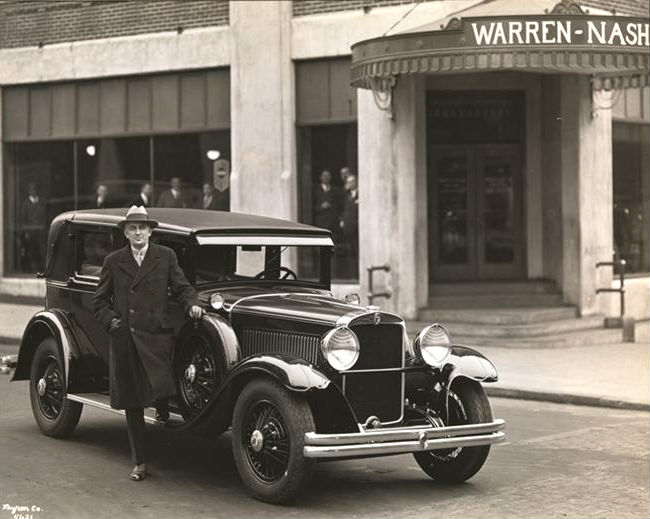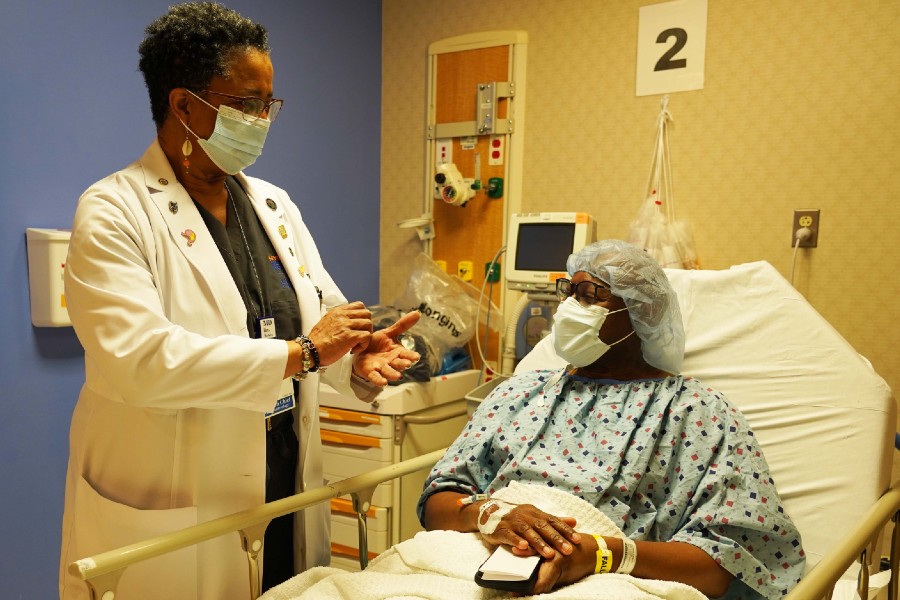 Nash Motors Company was an American automobile manufacturer based in Kenosha, Wisconsin, in the United States from 1916 to 1937. From 1937 to 1954, Nash Motors was the automotive division of the Nash-Kelvinator Corporation. Nash production continued from 1954 to 1957 after the creation of American Motors Corporation.
Nash Motors Company was an American automobile manufacturer based in Kenosha, Wisconsin, in the United States from 1916 to 1937. From 1937 to 1954, Nash Motors was the automotive division of the Nash-Kelvinator Corporation. Nash production continued from 1954 to 1957 after the creation of American Motors Corporation.
Nash pioneered unitary construction (1941), also a heating and ventilation system whose operating principles are now universally utilized (1938), seat belts (1950) and the manufacture of cars in the compact (1950), subcompact (1970) and muscle car (1957) categories.
Warren Nash Motors was founded in 1916 by former General Motors president Charles W. Nash (pictured in Harlem above and below on 169th Street and Broadway) who acquired the Thomas B. Jeffery Company. Jeffery’s best-known automobile was the Rambler whose mass production from a plant in Kenosha, Wisconsin began in 1902.
The 1917 Nash Model 671 was the first vehicle produced to bear the name of the new company’s founder. Nash enjoyed decades of success by focusing its efforts to build cars “embodying honest worth … [at] a price level which held out possibilities of a very wide market.”
The four-wheel drive Jeffrey Quad truck became an important product for Nash. Approximately 11,500 Quads were built between 1913 and 1919. They served to move material during World War I under severe conditions. The Quad used Meuhl differentials with half-shafts mounted above the load-bearing dead axles to drive the hubs through hub-reduction gearing. in addition to featuring four-wheel steering. The Quad achieved the reputation of being the best four-wheel drive truck produced in the country. The newly formed Nash Motors became the largest producer of four-wheel drives. By 1918, capacity constraints at Nash meant the Paige-Detroit Motor Car Company began to assemble the Nash Quad under license and Nash patents. Nash became the leading producer of military trucks by the end of World War I. After the war ended, surplus Quads were used as heavy work trucks in fields such as construction and logging.
 Charles Nash convinced the chief engineer of GM’s Oakland Division, Finnish-born Nils Eric Wahlberg, (around the same time the Nash’s company is opened in Hamilton Heights in Harlem (the name “Warren” was added, making it “Warren-Nash”, but we’re unsure of its origin). The first Nash engine introduced in 1917 by Wahlberg had overhead valves, and Nash incorporated this principle Wahlberg is also credited with helping to design flow-through ventilation that is used today in nearly every motor vehicle. Introduced in 1938, Nash’s Weather Eye directed fresh, outside air into the car’s fan-boosted, filtered ventilation system, where it was warmed (or cooled), and then removed through rearward placed vents. The process also helped to reduce humidity and equalize the slight pressure differential between the outside and inside of a moving vehicle. Another unique feature of Nash cars was the unequal wheel tracks. The front wheels were set slightly narrower than the rear, thus adding stability and improving cornering.
Charles Nash convinced the chief engineer of GM’s Oakland Division, Finnish-born Nils Eric Wahlberg, (around the same time the Nash’s company is opened in Hamilton Heights in Harlem (the name “Warren” was added, making it “Warren-Nash”, but we’re unsure of its origin). The first Nash engine introduced in 1917 by Wahlberg had overhead valves, and Nash incorporated this principle Wahlberg is also credited with helping to design flow-through ventilation that is used today in nearly every motor vehicle. Introduced in 1938, Nash’s Weather Eye directed fresh, outside air into the car’s fan-boosted, filtered ventilation system, where it was warmed (or cooled), and then removed through rearward placed vents. The process also helped to reduce humidity and equalize the slight pressure differential between the outside and inside of a moving vehicle. Another unique feature of Nash cars was the unequal wheel tracks. The front wheels were set slightly narrower than the rear, thus adding stability and improving cornering.
Wahlberg was also an early proponent of wind tunnel testing for vehicles (which led to the Nash Car 192 Model after a trip across the USA continent in 1926) and during World War II worked with Theodore (Ted) Ulrich in the development of Nash’s radically styled Airflyte models.
Nash’s slogan from the late 1920s and 1930s was “Give the customer more than he has paid for” and the cars lived up to it. Innovations included a straight-eight engine with overhead valves, twin spark plugs, and nine crankshaft bearings in 1930. The 1932 Ambassador Eight had synchromesh transmissions and free wheeling, automatic centralized chassis lubrication, a worm-drive rear end, and its suspension was adjustable inside the car.
The Nash was a success among consumers that meant for the company “selling for a long time has been 100% a production problem… month after month all the cars that could be produced were sold before they left the factory floor.”
For the 1925 model year, Nash introduced the entry-level marque Ajax. A car of exceptional quality for its price, the Ajax was produced in the newly acquired Mitchell Motor Car Company plant in Racine, Wisconsin. Mitchell was the manufacturer of Mitchell-brand automobiles between 1903 and 1923. Sales of Ajax automobiles, while quite respectable, were disappointing. It was believed that the same car would sell better if it were called a Nash. Thus the Ajax became the “Nash Light Six” in June, 1926 and sales did improve, just as expected. In an unusual move, Nash Motors offered all Ajax owners a kit to “convert” their Ajax into a Nash Light Six. This kit, supplied at no charge, included a set of new hubcaps, radiator badge, and all other parts necessary to change the identity of an Ajax into that of a Nash Light Six. This was done to protect Ajax owners from the inevitable drop in resale value when the Ajax marque was discontinued. In this way Nash Motors showed the high value they placed upon their customers’ satisfaction and well-being. Most Ajax owners took advantage of this move, and “unconverted” Ajax cars are quite rare today.
LaFayette Motors was the producer of a large, powerful, expensive luxury car. The company started in Indianapolis, Indiana, in 1920, and later moved to Milwaukee, Wisconsin. The principal stockholder in LaFayette Motors was Nash Motors Company. Other major stockholders were Charles W. Nash and friends and business associates. The high quality, high priced LaFayette cars did not sell well.
In 1924, Nash absorbed LaFayette Motors and converted its plant to produce Ajax automobiles. The LaFayette name was reintroduced in 1934 as a lower priced companion to Nash. LaFayette ceased to be an independent marque with the introduction of the 1937 models. From 1937 through 1940, the Nash LaFayette was the lowest priced Nash, and was replaced by the new unibody Nash 600 for the 1941 model year.
Before retiring, Charlie Nash chose Kelvinator Corporation head George W. Mason to succeed him. Mason accepted, but placed one condition on the job: Nash would acquire controlling interest in Kelvinator, which at the time was the leading manufacturer of high-end refrigerators and kitchen appliances in the United States. The resulting company, as of January 4, 1937, was known as the Nash-Kelvinator Corporation. Nash as a brand name continued to represent automobiles for Nash-Kelvinator. This was the largest merger of companies not in the same industry up until that time.
In 1938, Nash introduced an optional conditioned air heating/ventilating system, an outcome of the expertise shared between Kelvinator and Nash. This was the first hot-water car heater to draw fresh air from outside the car, and is the basis of all modern car heaters in use today. Also in 1938, Nash, along with other car manufacturers Studebaker and Graham, offered vacuum-controlled shifting, an early approach at removing the gearshift from the front floorboards. Automobiles equipped with the Automatic Vacuum Shift (supplied by the Evans Products Company) had a small gear selector lever mounted on the dashboard, immediately below the radio controls.
In 1936, Nash introduced the “Bed-In-A-Car” feature (see photo above), which allowed the car’s interior to be converted into a sleeping compartment. The rear seatback hinged up, allowing the rear seat cushion to be propped up into a level position. This also created an opening between the passenger compartment and the trunk. Two adults could sleep in the car, with their legs and feet in the trunk, and their heads and shoulders on the rear seat cushions. In 1949 this arrangement was modified so that fully reclining front seatbacks created a sleeping area entirely within the passenger compartment. In 1950 these reclining seatbacks were given the ability to lock into several intermediate positions. Nash soon called these new seatbacks “Airliner Reclining Seats”.
In 1939, Nash added a thermostat to its “Conditioned Air System”, and thus the famous Nash Weather Eye heater was born. The 1939 and 1940 Nash streamlined cars were designed by George Walker and Associates and freelance body stylist Don Mortrude. They were available in three series – LaFayette, Ambassador Six and Ambassador Eight. For the 1940 model cars Nash introduced independent coil spring front suspension and sealed beam headlights.
The 1941, Nash 600 was the first mass-produced unibody construction automobile made in the United States. .
The aerodynamic 1949 Nash Airflyte “600” was the first car of an advanced design introduced by the company after the war. Its aerodynamic body shape was developed in a wind tunnel. Nils Wahlberg’s theories on reducing an automobile body’s drag coefficient resulted in a smooth shape and enclosed front fenders. The “cutting-edge aerodynamics” was the most “alarming” all-new postwar design in the industry. A one-piece curved safety glass windshield was used on both models.
A new first for an American car were seat belts, also new was a five-position Airliner reclining front passenger seat back, both optional in both models. He directed Nash towards the development of the first compact of the post war era, the 1950 Nash Rambler. Nash was one of the few American car manufacturers to introduce an all-new 1952 model other than Ford Motor Company. Using its Kelvinator refrigeration experience, the automobile industry’s first single-unit heating and air conditioning system was introduced by Nash in 1954. The alternative layout pioneered by Nash “became established practice and continues to form the basis of the modern and more sophisticated automatic climate control systems.”
In 1970, American Motors acquired Kaiser Jeep (the descendant of Willys-Overland Motors) and its Toledo, Ohio, based manufacturing facilities. In the early 1980s, AMC entered into a partnership with Renault which was looking for a re-entrée into the American market in the 1980s. AMC was ultimately acquired by Chrysler Corporation in 1987, becoming the Jeep-Eagle division.
Photo credit: 1-2). Mr. Warren, in front of the window and the 100,000th car sold on cobblestone street at 169th Street and Broadway around 1928. 3) The service station of Warren-Nash Motor Corp. at 133rd Street & Broadway. Servicemen are working on cars. 1928.
Become a Harlem Insider!
By submitting this form, you are consenting to receive marketing emails from: Harlem World Magazine, 2521 1/2 west 42nd street, Los Angeles, CA, 90008, https://www.harlemworldmagazine.com. You can revoke your consent to receive emails at any time by using the SafeUnsubscribe® link, found at the bottom of every email. Emails are serviced by Constant Contact









